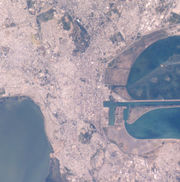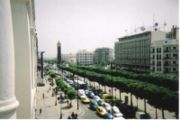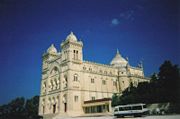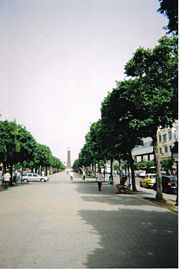Tunis
2008/9 Schools Wikipedia Selection. Related subjects: Africa; Cities
| Tunis تونس |
|
| Tunis by Night | |
| Coordinates: | |
|---|---|
| Country | Tunisia |
| Governorates | Tunis Governorate |
| Government | |
| - Mayor | Abbes Mohsen |
| Area | |
| - Total | 212.63 km² (82.1 sq mi) |
| Population (2007) | |
| - Total | 728,453 |
| - Density | 3,425.9/km² (8,873/sq mi) |
| Time zone | CET ( UTC+1) |
| - Summer ( DST) | CEST ( UTC+2) |
| Website: commune-tunis.gov.tn | |

Tunis (Arabic: تونس, Tūnis) is the capital of the Tunisian Republic and also the Tunis Governorate, with a population of 728,453 in 2004. Informal estimates state that the population of greater Tunis approaches two million. It is Tunisia's largest city.
Situated on a large Mediterranean gulf, (the Gulf of Tunis), behind the Lake of Tunis and the port of La Goulette (Halq al Wadi), the city extends along the coastal plain and the hills that surround it. At the centre of more modern development (colonial era and post) lies the old medina. Beyond this section lie the suburbs of Carthage, La Marsa, and Sidi Bou Said.
The medina is found at the centre of the city: a dense agglomeration of alleys and covered passages, full of intense scents and colours, boisterous and active trade, a surfeit of goods on offer ranging from leather to plastic, tin to the finest filigree, tourist souvenirs to the works of tiny crafts-shops.
Just through the Sea Gate (also known as the Bab el Bahr and the Porte de France), begins the modern city, or Ville Nouvelle, transversed by the grand Avenue Bourguiba (considered by many to be the Tunisian Champs-Élysées), where the colonial-era buildings provide a clear contrast to smaller older structures. As the capital city of the country Tunis is the centre of Tunisian commercial activity, as well as focus of political and administrative life in the country. The expansion of the Tunisian economy in the last decades is reflected in the booming development of the outer city where one can see clearly the social challenges brought about by rapid modernization in Tunisia.
Geography
Tunis is located in north-eastern Tunisia on the Lake of Tunis, and is connected to the Mediterranean sea's Gulf of Tunis by a canal which terminates at the port of La Goulette / Halq al Wadi. The ancient city of Carthage is located just north of Tunis along the coastal part. Tunis is located at ().
History
Early history
In the 2nd millennium BC a town, originally named Tunes, was founded by Berbers and also over time occupied by Numidians. In the 9th century BC, the city was taken over by Phoenicians from Carthage. The Berbers took control of Tunis in 395 BC but it was soon lost when Agathocles invaded Africa and established his headquarters there. When Agathocles left Africa, the Carthaginians took control of the city once again.
In 146 BC, the Romans destroyed Tunis (along with Carthage). However, the city was subsequently rebuilt under the rule of Augustus and became an important town under Roman control and the centre of a booming agricultural industry.
Islamic Control
It was not until the 7th century, after the final destruction of Carthage, that the city achieved its own importance under the control of Arab Muslims. It was at this time that the medina of Tunis was first built.
From the 12th century to the 16th century, the old city was controlled by the Almohad and the Hafsid Berber dynasties. During this time, Tunis was one of the richest and grandest cities in the Islamic world, with a population of about 100,000.
Ottoman rule and piracy
The Ottoman Empire took nominal control of the city in 1534 when Barbarossa Hayreddin captured it from the Hafsid Sultan, Mulai Hassan. Mulai Hassan fled to the court of Charles V, Holy Roman Emperor and King of Spain. Charles, who suffered at the hands of the corsairs operating out of Djerba, Tunis and Algiers, agreed to reinstate Mulai-Hassan in exchange for an acceptance of Spanish suzerainty by Mulai-Hassan. A naval expedition led by Charles himself was dispatched in 1535 and the city was quickly recaptured. The victory against the corsairs is recorded in a tapestry at the Royal Palace of Madrid. The resulting protectorate lasted until the Ottomans retook Tunis in 1574. After 1591, the Ottoman governors ( Beys) were relatively independent and piracy and trade continued to flourish.
In April 1655, English Admiral Robert Blake was sent to the Mediterranean to extract compensation from states that had been attacking English shipping. Only the Bey of Tunis refused to comply, with the result that Blake's 15 ships attacked the Bey's arsenal at Porto Farina (Ghar el Melh), destroying nine Algerian ships and two shore batteries, the first time in naval warfare that shore batteries had been taken out without landing men ashore.
European colonialism
The French occupied the city from 1881 to 1956 having established a protectorate system of administration that recognized the nominal authority of local government. In those years there were huge European colonies (like the Tunisian Italians) in Tunis and the city experienced a great expansion with the creation of new boulevards.
During World War II, Tunis was held by Axis forces from November 1942 to May 1943, and was their last base in Africa.
Modern history
The Arab League was headquartered in Tunis from 1979 to 1990.The Arab League, which represents 22 Arab nations, transferred its headquarters to Tunis in 1979 because of Egypt's peace with Israel but headquartered back in Egypt since 1990.
The Palestine Liberation Organization also had its headquarters in Tunis, from 1970s to 2003. In 1985, the PLO's headquarters was bombed by the Israeli Air Force, killing approximately 60 people.
Landmarks
The medina
The medina of Tunis has been a UNESCO World Heritage Site since 1979. The medina contains some 700 monuments, including palaces, mosques, mausoleums, madrasas and fountains dating from the Almohad and the Hafsid periods. These ancient buildings include
- the Great Mosque (including the Muslim University and library)
- Aghlabid Ez-Zitouna Mosque ("Mosque of the Olive") built in 723 by Obeid Allah Ibn-al-Habhab to celebrate the new capital.
- the Dar-al-Bey, or Bey's Palace, comprises architecture and decoration from many different styles and periods and is believed to stand on the remains of a Roman theatre as well as the tenth century palace of Ziadib-Allah II al Aghlab.
Other landmarks
- The Bardo Museum was originally a 13th century Hafsid palace, located in the (then) suburbs of Tunis. It contains a major collection of Roman empires and other antiquities of interest from Ancient Greece, Tunisia, and from the Arab period.
- The ruins of Carthage are nearby, along the coast to the northeast, the old capital of the Carthaginian Empire, with many ancient ruins.
Economy
Products include textiles, carpets, and olive oil. Tourism also provides a significant portion of the city's income.
Transport
Tunis is served by the Tunis-Carthage International Airport. The growing metropolitan area is served by an extensive network of public transportation including buses, an above-ground light rail system (le Metro), as well a regional train line (le TGM) that links the city centre to its closest northern suburbs. Multi-lane autoroutes surround the city and serve the increasing number of privately owned cars one encounters in Tunisia.
The Tunis area is served by the métro léger (Ar.: المترو الخفيف لمدينة تونس) and TGM (Tunis-Goulette-Marsa), as well as bus services, and is linked to other places in Tunisia by SNCFT, the national railways.
- TRANSTU - Société des Transports de Tunis
- OACA - Ministry of Transport (Airports)
Education
Tunis is the site of the University of Tunis as well as Tunisia Private University.






